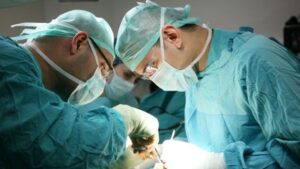
Hernia repair has witnessed remarkable advancements over the years, evolving from open surgery to minimally invasive laparoscopic techniques. Today, robotic hernia surgery is setting new standards in precision, safety, and recovery, especially for patients seeking the best surgical care in Mumbai.
This blog explores what robotic hernia surgery is, its benefits compared to traditional and laparoscopic methods, common procedures, recovery expectations, and where to access expert robotic hernia surgeons in Mumbai.
What is Robotic Hernia Surgery?
Robotic hernia surgery is a cutting-edge minimally invasive procedure where surgeons use robotic-assisted technology to repair hernias. The robotic system enhances the surgeon’s ability to perform complex movements through tiny incisions with unparalleled precision.
Using robotic arms controlled via a console, the surgeon manipulates instruments equipped with wristed joints that mimic human hand movements but with greater dexterity and steadiness. A 3D high-definition camera offers a magnified view, allowing for meticulous dissection and mesh placement.
Types of Hernias Treated with Robotic Surgery
Robotic surgery can address various types of hernias, including:
-
Inguinal Hernia (groin area)
-
Umbilical Hernia (near the belly button)
-
Incisional Hernia (at previous surgical sites)
-
Hiatal Hernia (upper stomach area)
This technology is especially beneficial for complex, recurrent, or bilateral hernias requiring intricate repair.
Advantages of Robotic Hernia Surgery
Enhanced Precision and Control
The robotic system translates the surgeon’s hand movements into precise micro-movements inside the patient’s body. This enables careful tissue handling and reduces trauma to surrounding structures.
Minimally Invasive Approach
Robotic surgery uses small incisions, reducing pain, scarring, and infection risk. Patients experience faster healing compared to traditional open surgery.
Better Visualization
Surgeons operate with a 3D high-definition view, providing better depth perception and clarity than standard laparoscopy.
Shorter Hospital Stay and Recovery Time
Patients typically recover quicker and can return to work and daily activities sooner.
Reduced Risk of Recurrence
Improved precision allows for optimal mesh placement and secure hernia repair, decreasing chances of hernia recurrence.
Robotic Hernia Surgery Procedure Overview
-
Preoperative Preparation: Patients undergo medical evaluation, imaging, and counseling.
-
Anesthesia: General anesthesia is administered.
-
Incisions: Small keyhole incisions (usually 3-4) are made.
-
Robotic Docking: The robotic arms and camera are positioned.
-
Hernia Repair: Surgeon operates the robotic system to reduce the hernia and place mesh over the defect.
-
Closure: Incisions are closed with minimal suturing.
-
Recovery Room: Patients monitored post-surgery before discharge.
Robotic Hernia Surgery vs. Traditional and Laparoscopic Methods
| Aspect | Open Surgery | Laparoscopic Surgery | Robotic Surgery |
|---|---|---|---|
| Incision Size | Large | Small | Small |
| Visualization | Direct, 2D | 2D monitor | 3D high-definition |
| Instrument Dexterity | Surgeon’s hands only | Limited wrist movement | Enhanced wristed instruments |
| Recovery Time | Long | Shorter | Shortest |
| Precision | Limited | Good | Superior |
| Pain and Scarring | More | Less | Minimal |
Who is a Candidate for Robotic Hernia Surgery?
Robotic hernia surgery is suitable for most patients requiring hernia repair, especially:
-
Those with recurrent hernias after previous surgery.
-
Patients with bilateral hernias.
-
Complex or large hernias.
-
Patients seeking minimally invasive options with rapid recovery.
However, the final suitability depends on individual evaluation by a robotic surgery specialist.
Recovery After Robotic Hernia Surgery
Postoperative recovery is generally smooth with robotic surgery:
-
Hospital stay is usually 1-2 days.
-
Patients can resume light activities within days.
-
Pain and discomfort are minimal compared to open surgery.
-
Strenuous activities and heavy lifting should be avoided for 4-6 weeks.
-
Follow-up visits ensure proper healing.
Cost of Robotic Hernia Surgery in Mumbai
Robotic surgery typically costs more than laparoscopic or open surgery due to advanced technology and expertise. Prices generally range from INR 1,50,000 to INR 4,00,000 depending on the hospital, surgeon, and case complexity.
Finding the Best Robotic Hernia Surgery Specialists in Mumbai
Mumbai hosts some of India’s top hospitals and surgeons specializing in robotic hernia surgery. Institutions equipped with the da Vinci Surgical System or equivalent robotic platforms provide world-class care.
Leading Hospitals Offering Robotic Hernia Surgery in Mumbai
-
Kokilaben Dhirubhai Ambani Hospital
-
Lilavati Hospital & Research Centre
-
Breach Candy Hospital
-
Jaslok Hospital & Research Centre
-
Hiranandani Hospital
Choosing the Right Surgeon
-
Verify surgeon credentials and robotic surgery experience.
-
Seek consultations to understand the procedure and ask questions.
-
Check hospital infrastructure and patient reviews.
-
Ensure transparent discussion about costs and insurance coverage.
Conclusion
Robotic hernia surgery is revolutionizing the treatment of hernias by combining minimally invasive techniques with robotic precision. Patients in Mumbai benefit from this advanced technology with faster recovery, less pain, and superior surgical outcomes.
If you or someone you know suffers from a hernia, consulting a robotic surgery specialist in Mumbai could provide access to this cutting-edge option. Embrace the future of hernia repair with robotic technology for a safer, quicker return to normal life.